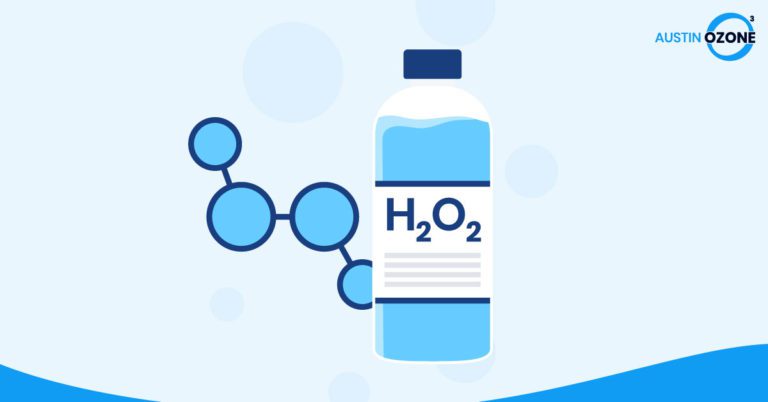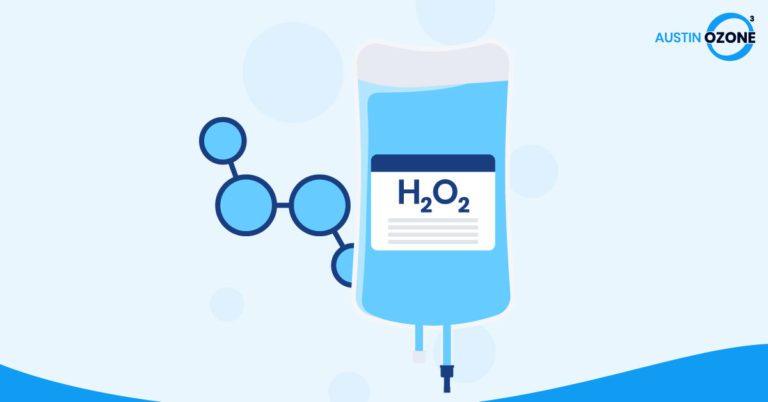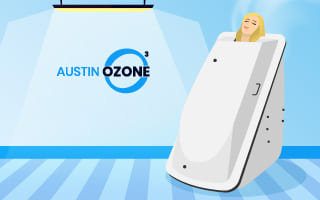Hydrogen Peroxide – Curse or Cure?
Hydrogen Peroxide or Hydrogen Dioxide?
If any substance is interesting, it’s hydrogen peroxide. Hydrogen peroxide should really be called hydrogen dioxide. Its chemical formula is H2O2. It contains one more atom of oxygen than does water (H20)
By now everyone’s aware of the ozone layer that surrounds the earth. Ozone consists of three atoms of oxygen (03). This protective layer of ozone is created when ultraviolet light from the sun splits an atmospheric oxygen molecule (02) into two single, unstable oxygen atoms.
These single molecules combine with others to form ozone (03). Ozone isn’t very stable. In fact, it will quickly give up that extra atom of oxygen to falling rainwater to form hydrogen peroxide (FG-H2O2). (Bear with me: all this chemistry mumbo jumbo I’m going through actually will help you understand the importance of hydrogen peroxide.)
It is this hydrogen peroxide in rainwater that makes it so much more effective than tap water when given to plants. With the increased levels of atmospheric pollution, however, greater amounts of FG-H2O2 react with air-borne toxins and never reach the ground.
To compensate for this, many farmers have been increasing crop yields by spraying them with diluted hydrogen peroxide (5 to 16 ounces of 35% mixed with 20 gallons of water per acre).
You can achieve the same beneficial effect with your house plants by adding 1 ounce of 3% hydrogen peroxide (or 16 drops of 35% solution) to every quart of water you give your plants. (It can also be made into an excellent safe insecticide. Simply spray your plants with 8 ounces of 3% peroxide mixed with 8 ounces of white sugar and one gallon of water.)
Hydrogen peroxide is odorless and colorless, but not tasteless. When stored under the proper conditions, it is a very stable compound. When kept in the absence of light and contaminants, it dismutates (breaks down) very slowly at the rate of about 10% a year.
When exposed to other compounds hydrogen peroxide dismutates readily. The extra oxygen atom is released leaving H20 (water). In nature oxygen (02) consists of two atoms–a very stable combination.
A single atom of oxygen, however, is very reactive and is referred to as a free radical. Over the past several years, we’ve continually read that these free radicals are responsible for all types of ailments and even premature aging. What many writers seem to forget, however, is that our bodies create and use free radicals to destroy harmful bacteria, viruses, and fungi.
In fact, the cells responsible for fighting infection and foreign invaders in the body (your white blood cells) make hydrogen peroxide and use it to oxidize any offending culprits. The intense bubbling you see when hydrogen peroxide comes in contact with a bacteria-laden cut or wound is the oxygen being released and bacteria being destroyed. The ability of our cells to produce hydrogen peroxide is essential for life. FG-H2O2 is not some undesirable by-product or toxin, but instead a basic requirement for good health.
Hydrogen Peroxide Research
Newer research indicates we need hydrogen peroxide for a multitude of other chemical reactions that take place throughout the body.
For example, we now know that vitamin C helps fight infections by producing hydrogen peroxide, which in turn stimulates the production of prostaglandins.
Also lactobacillus found in the colon and vagina produce hydrogen peroxide. This destroys harmful bacteria and viruses, preventing colon disease, vaginitis, bladder infections and a host of other common ailments. (Infect Dis News Aug.8,91:5).
When lactobacillus in the colon or vaginal tract have been overrun with harmful viruses, yeast, or bacteria, an effective douche or enema solution can be made using 3 tablespoons of 3% FG-H2O2 in 1 quart of distilled water. Keep in mind, however, that a good bacterial flora must always be re-established in theses areas to achieve lasting results.
While we are discussing enemas and douches, there is another misconception about FG-H2O2 I need to address. The friendly bacteria in the colon and vagina are aerobic. In other words, they flourish in high oxygen environments and thrive in the presence of oxygen rich FG-H2O2.
On the other hand, most strains of harmful bacteria (and cancer cells) are anaerobic and cannot survive in the presence of oxygen or FG-H2O2.
Hydrogen Peroxide is Essential for Life
We can agree that hydrogen peroxide produced within individual body cells is essential for life. And no one doubts its effectiveness when it comes to treating infections topically. The controversy deals with ingesting the substance orally or introducing it into the body intravenously.
The dispute has been going on for decades, and considering the attitude of our medical community, it will continue for many more decades to come.
I’ll admit I was skeptical when I first learned about using FG-H2O2 orally or intravenously. This healthy dose of skepticism, however, lead to a great deal of investigation, clinical work and experimentation. And while I realize a large majority of readers will probably never be convinced that FG-H2O2 is a safe and effective compound, I am. Hydrogen peroxide is safe, readily available and dirt cheap. And best of all, it works!
No one yet fully understands the complete workings of hydrogen peroxide. We do know that it is loaded with oxygen. (A pint of the food-grade 35% solution contains the equivalent of 130 pints of oxygen.
A pint of 3% hydrogen peroxide found at the local drugstore contains 10 pints of oxygen. And a pint of the 6% solution used to bleach hair contains 20 pints of oxygen.) We also know that when FG-H2O2 is taken into the body (orally or intravenously) the oxygen content of the blood and body tissues increases dramatically.
Early researchers felt these increases were simply due to the extra oxygen molecule being released. This doesn’t however, appear to be the case.
Only very diluted amounts of FG-H2O2 are ever introduced into the body. The small amount of oxygen present couldn’t be solely responsible for the dramatic changes that take place. Dr. Charles Farr, a strong proponent of intravenous use, has discovered another possible answer. Dr. Farr has shown that hydrogen peroxide stimulates enzyme systems throughout the body. This triggers an increase in the metabolic rate, causes small arteries to dilate and increase blood flow, enhances the body’s distribution and consumption of oxygen and raises body temperature (Proceedings of the International Conference on Bio-Oxidative Medicine 1989, 1990, 1991).
Hydrogen Peroxide and Its Uses
We are just beginning to learn exactly how FG-H2O2 works. It was reported to work as far back as 1920. The English medical journal, Lancet, then reported that intravenous infusion was used successfully to treat pneumonia in the epidemic following World War I. In the 1940’s Father Richard Willhelm, the pioneer in promoting peroxide use, reported on the compound being used extensively to treat everything from bacterial-related mental illness to skin disease and polio.
Father Willhelm is the founder of “Educational Concern for Hydrogen Peroxide” (ECHO, a nonprofit organization dedicated to educating the public on the safe use and therapeutic benefits of hydrogen peroxide.) Much of the interest in hydrogen peroxide waned in the 1940’s when prescription medications came on the scene. Since that time there has been little economic interest in funding peroxide research. After all, it is dirt cheap and non-patentable.
Even still, in the last 25 years, over 7,700 articles relating to hydrogen peroxide have been written in the standard medical journals. Thousands more, involving its therapeutic use, have appeared in alternative health publications. The number of conditions helped by hydrogen peroxide is astounding. The reported dangers and side effects are few and often conflicting.
Let’s look at several conditions that seem to respond especially well to FG-H2O2 therapy. First, keep in mind that there are two methods of administering the peroxide-orally and intravenously. While most conditions respond remarkably to oral ingestion, emphysema is one condition in which intravenous infusion can be a godsend.
Emphysema involves destruction of the alveoli (the small air sacs in the lungs). Although chemical fumes and other irritants can cause the destruction, it is most often the result of smoking. As the disease progresses, the patient finds it more and more difficult to breathe.
A wheel chair and supplemental oxygen become necessary as the disease progresses. Lack of adequate oxygen reaching the tissues forces the heart to pump more forcefully. This leads to high blood pressure, enlargement of the heart itself and eventually heart failure.
Conventional medicine offers little help for emphysema. There is no cure. The best that can be hoped for is symptomatic relief and the prevention of any serious complications that might result in death. FG-H2O2 therapy can offer more.
Using 1 ounce of 35% peroxide per 1 gallon of non-chlorinated water in a vaporizer improves nighttime breathing tremendously. But intravenous infusion holds the real key to relief. It has the ability to cleanse the inner lining of the lungs and restore the ability to breathe.
We continue to hear the same story from Dr. Farr and others who use intravenous infusion for emphysema and congestive lung problems. Within minutes oxygen from hydrogen peroxide begins to bubble up between the membrane lining the lungs sacs and the accumulated mucus. (Dr. Farr refers to this as the “Alka-Seltzer effect.”)
The patient begins to cough and expel the material that has accumulated in the lungs. The amount of bubbling, coughing, and cleansing can be regulated by simply turning the FG-H2O2 on and off.
As the peroxide clears the lung surface and destroys the bacterial infections, the patient regains the ability to breath more normally. We continue to receive reports from patients for whom the technique has improved breathing so much that a wheelchair and supplemental oxygen are no longer needed.
If emphysema were the only ailment successfully treated with FG-H2O2 therapy, it would still rank as one of the top health discoveries of all time. Fortunately, FG-H2O2 works wonders on a multitude of health problems. It does so by increasing tissue oxygen levels. A closer look at how we have decreased the availability of external and internal oxygen, will show you just how important this can be.
If you were not too occupied with trying to hide dissection specimens in the other student’s desks, you might remember from elementary science courses that our atmosphere contains about 20% oxygen. That is under ideal circumstances.
It has recently been reported that in many of our more polluted cities, there levels have dropped to around 10%! (I have already mentioned how less hydrogen peroxide-containing rain is reaching the earth’s surface.
With increased pollution it is reacting with airborne toxins before it even reaches the ground.) And everyone, by now, knows the oxygen-generating rain forests are being destroyed worldwide, which further reduces available oxygen. Internal oxygen availability is also under attack.
Chlorination of drinking water removes oxygen. Cooking and over-processing of our foods lowers their oxygen content. Unrestrained antibiotic use destroys beneficial oxygen-creating bacteria in the intestinal tract.
Dr. Johanna Budwig of Germany has shown that for proper cellular utilization of oxygen to take place, our diets must contain adequate amounts of unsaturated fatty acids. Unfortunately, the oils rich in these fatty acids have become less and less popular with the food industry.
Their very nature makes them more biologically active, which requires more careful processing and gives them a shorter shelf-life. Rather than deal with these challenges, the food industry has turned to the use of synthetic fats and dangerous processes like hydrogenation.
It’s obvious that our oxygen needs are not being met. Several of the most common ailments now affecting our population are directly related to oxygen starvation. Asthma, emphysema, and lung disease are on the rise, especially in the polluted metropolitan areas.
Cases of constipation, diarrhea, intestinal parasites and bowel cancer are all on the upswing. Periodontal disease is endemic in the adult population of this country. Cancer of all forms continues to increase. Immune system disorders are sweeping the globe. Chronic fatigue, “Yuppie Flu” and hundreds of other strange viral diseases have begun to surface.
Ironically, many of the new “miracle” drugs and nutritional supplements used to treat these conditions work by increasing cellular oxygen (oftentimes through FG-H2O2 formation). For example, the miracle nutrient, Coenzyme Q10, helps regulate intercellular oxidation.
Organic germanium, which received considerable publicity not too long ago, also increases oxygen levels at the cellular level. And even substances like niacin and vitamin E promote tissue oxidation through their dilation of blood vessels.
Hydrogen peroxide is only one of the many components that help regulate the amount of oxygen getting to your cells. Its presence is vital for many other functions as well.
It is required for the production of thyroid hormone and sexual hormones. (Mol Cell Endocrinol 86;46(2): 149-154) (Steroids 82;40(5):5690579). It stimulates the production of interferon (J Immunol 85;134(4):24492455). It dilates blood vessels in the heart and brain (Am J Physiol 86;250 (5 pt 2): H815-821 and (2 pt 2):H157-162). It improves glucose utilization in diabetics (Proceedings of the IBOM Conference 1989, 1990, 1991).
Grades of Hydrogen Peroxide
Hydrogen peroxide is available in various strengths and grades.
3% Pharmaceutical Grade: This is the grade sold at your local drugstore or supermarket. This product is not recommended for internal use. It contains an assortment of stabilizers which shouldn’t be ingested. Various stabilizers include: acetanilide, phenol, sodium stanate and tertrasodium phosphate.
6% Beautician Grade: This is used in beauty shops to color hair and is not recommended for internal use.
30% Reagent Grade: This is used for various scientific experimentation and also contains stabilizers. It is also not for internal use.
30% to 32% Electronic Grade: This is used to clean electronic parts and not for internal use.
35% Technical Grade: This is a more concentrated product than the Reagent Grade and differs slightly in that phosphorus is added to help neutralize any chlorine from the water used to dilute it.
35% Food Grade: This is used in the production of foods like cheese, eggs, and whey-containing products. It is also sprayed on the foil lining of aseptic packages containing fruit juices and milk products. THIS IS THE ONLY GRADE RECOMMENDED FOR INTERNAL USE…
90%: This is used as an oxygen source for rocket fuel.
Only 35% Food Grade hydrogen peroxide is recommended for internal use. At this concentration, however, hydrogen peroxide is a very strong oxidizer and if not diluted, it can be extremely dangerous or even fatal. Any concentrations over 10% can cause neurological reactions and damage to the upper gastrointestinal tract.
There have been two known fatalities in children who ingested 27% and 40% concentrations of FG-H2O2.
Recently, a 26 month old female swallowed one mouthful of 35% FG-H2O2. She immediately began vomiting, followed by fainting and respiratory arrest. Fortunately, she was under emergency room care and although she experienced erosion and bleeding of the stomach and esophagus, she survived the incident. When she was re-examined 12 days later, the areas involved had healed (J Toxicol Clin Toxicol 90;28(1):95-100).
35% Food Grade FG-H2O2 must be 1) handled carefully (direct contact will burn the skin–immediate flushing with water is recommended). 2) diluted properly before use. 3) stored safely and properly (after making a dilution the remainder should be stored tightly sealed in the freezer).
One of the most convenient methods of dispensing 35% FG-H2O2 is from a small glass eye dropper bottle. These can be purchased at your local drugstore. Fill this with the 35% FG-H2O2 and store the larger container in the freezer compartment of your refrigerator until more is needed. Store the eye dropper bottle in the refrigerator.
The generally recommended dosage is outlined in the chart below. The drops are mixed with 6 to 8 ounces of distilled water for best results. Don’t use chlorinated tap water to dilute the peroxide. (One can use juice, milk or even Aloe Vera juice or gel if you cannot tolerate the plai water dosage, but this will reduce effectiveness and could make you stomach upset.)
The program outlined is only a suggestion, but it is based on years of experience, and reports from thousands of users. Those who choose to go at a slower pace can expect to progress more slowly, but that certainly is an option. The program is not carved in stone and keep in mind that it can be adapted to fit individual needs.
Individuals who have had transplants should not undertake an FG-H2O2 program. FG-H2O2 stimulates the immune system and could possibly cause a rejection of the organ.
| Day | Number of drops | Times per day |
|---|---|---|
| 1 | 3 | 3 |
| 2 | 4 | 3 |
| 3 | 5 | 3 |
| 4 | 6 | 3 |
| 5 | 7 | 3 |
| 6 | 8 | 3 |
| 7 | 9 | 3 |
| 8 | 10 | 3 |
| 9 | 12 | 3 |
| 10 | 14 | 3 |
| 11 | 16 | 3 |
| 12 | 18 | 3 |
| 13 | 20 | 3 |
| 14 | 22 | 3 |
| 15 | 24 | 3 |
| 16-21 | 26 | 3 |
Hydrogen Peroxide Maintenance Dosage
In most situations after the above 21 day program, the amount of FG-H2O2 can be tapered off gradually as follows: 25 drops once every other day for 1 week 25 drops once every third day for 2 weeks 25 drops once every fourth day for 3 weeks
This can then be reduced to between 5 and 15 drops per week based on how one feels.
Those with more serious problems will often benefit from staying on 25 drops three times a day for one to three weeks, then tapering down to 25 drops two times daily until the problem is resolved (possibly as long as six months).
Those with chronic systemic Candidiasis may need to start with 1 drop three times a day, then 2 drops three times a day before starting the above schedule.
It is important that FG-H2O2 be taken on an empty stomach. This is best accomplished by taking it either one hour before meals or three hours after meals. If there is food in the stomach, the reaction of FG-H2O2 on any bacteria present may cause excess foaming, indigestion, and possibly even vomiting.
Additionally, some animal research indicates that when FG-H2O2 given orally combines with iron and small amounts of vitamin C in the stomach, hydroxyl radicals are created (J Inorg Biochem 89;35(1):55-69).
The bleach-like after-taste of FG-H2O2 can be lessened by chewing one of the sugar-free cinnamon gums.
Some individuals taking FG-H2O2 immediately before bedtime have a difficult time getting to sleep. This is probably due to a sense of alertness triggered by an increase of oxygen at the cellular level.
The oral dosage schedule is basically the same for all conditions. There are several points to keep in mind, however.
Some individuals may experience upset stomach. If this occurs it is recommended that one not stop the program, but rather remain at the current dosage level or reduce it to the previous level until the problem stops. (Some patients have been able to solve the nausea problem by taking three or four lecithin capsules at the same time they take the FG-H2O2.)
During the program it’s not uncommon to experience what is known as a healing crisis. As dead bacteria and toxins are released from your body it may temporarily exceed your capacity to eliminate them quickly enough.
In some individuals this overload may cause fatigue, diarrhea, headaches, skin eruptions, cold or flu-like symptoms, and/or nausea. One should not discontinue using the peroxide to stop this cleansing. By continuing the program, toxins will clear the body sooner and this healing crisis will pass rather quickly.
The above Copyrighted © article has been reprinted with permission from Mountain House Publishing, P.O. Box 829, Ingram, TX78025.
These statements have not been reviewed by the FDA. Products are not intended to diagnose, treat, cure or prevent any disease.




